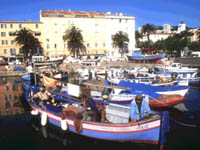
The popular holiday destination of Ajaccio lies in a calm bay on the west coast of the rugged island of Corsica, set against a backdrop of wooded hills. It is a relaxed rather than lively town and visitors come here on holiday to enjoy its wealth of cafés, restaurants and shops. There are many cocktail bars overlooking the bay on boulevard Lantivy, so visitors will find plenty of lovely watering holes. Ajaccio is a good doorstep into the rest of the island, and the launching point for many Corsican holidays.The birthplace of Napoleon Bonaparte, the town takes full advantage of its famous resident to lure tourists. Attractions include the magnificent cathedral where he was christened, the Bonaparte residence, and numerous statues and street names related to his family. While locals are not particularly proud of their notorious famous son, they are justifiably proud of the art collection of his uncle, Cardinal Fesch. Housed in the Musée Fesch, this collection of Italian paintings is considered to rate second only to that of the Louvre and is well worth seeing while on holiday in Ajaccio.Most souvenirs from Ajaccio are related somehow to Napoleon, but visitors should not overlook the region's excellent wine. Ajaccio has its fair share of little shops but it is not a shopping paradise.
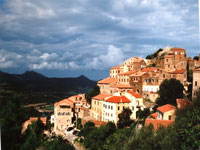
The inland area along the northwest coast of Corsica has been renowned since Roman times as an orchard of olive, fig and orange trees and the breadbasket of the island, crisscrossed by a network of narrow, winding roads. Tiny villages such as Sant'Antonino and Speloncato perch high above the countryside, built around rocky outcrops, while others along the Artisan's Route, like Pigna, proudly display their traditional crafts, such as pottery and stringed instruments. Set beneath a wall of imposing jagged mountains that remain snow-capped until July, the rocky coastline of the Balagne area shelters a string of stunning white sand beaches and an old fishing settlement, now turned into one of the island's most popular holiday resort towns, at Calvi.In the shadow of its citadel, built by the Genoese, Calvi bathes in the legend of Christopher Columbus whose birthplace it is said to be. It was during an attack on Calvi that another famous mariner, Lord Nelson, lost his eye. Not far away from this historic and compact gem can be found another port town, Ile Rousse, founded by Pascal Paoli in direct contrast to Calvi, which he felt was too Genoese. Many of the settlements along the Balagne coast have been developed into busy holiday villages; however, the stunning scenery and idyllic beaches more than compensate for the crowds. Trains connect Calvi and Ile Rousse with Ajaccio and Bastia. Buses are also available.
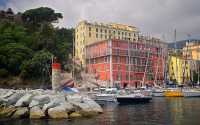
Situated in the northeast of Corsica, Bastia is the island's major commercial centre. Despite this the old town has retained its charms as a holiday destination, with opulent Baroque churches and crumbling pastel houses lining the maze of tightly packed streets and alleyways. The Vieux Port is the most photogenic part of town, where old houses tower above the harbour and the reflections from colourful fishing vessels ripple on the water. The citadel perched high on the headland of Bastia dominates the other side. The Bastia harbour comes alive in the evening when tourists and locals fill the waterside bars and restaurants. The pebble beaches below Bastia town tend to be very crowded in summer and sun seekers are advised to head further south where a sandy shore extends for miles down the east coast of the island. There are some lovely walking trails in the area and it is also delightful to explore by train. There are also lots of ferries and boats available to head out into the bay.
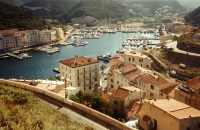
The ancient town of Bonifacio, at the very southern tip of Corsica, dates from about 833 AD, but there is nothing old-fashioned about the tourist trappings and commercialisation of this buzzing haven, which attracts huge holiday crowds, particularly in summer, now combining its ancient heritage with a glamorous resort atmosphere. The visitors come on holiday here for the magnificent setting: Bonifacio sits on a narrow limestone peninsula, the bright white cliffs plunging into the Bouches de Bonifacio strait, between Corsica and Sardinia.The most scenic way to approach Bonifacio is by boat through the channel, almost a mile long, that protects the town's beautiful natural harbour. No wonder that the buzzing marina attracts yachts from all over the world, as well as ferries and passenger boats packed with tourists arriving on holiday from Sardinia and elsewhere. Alternatively, visitors can fly into Bonifacio from Marseille or bus from the other Corsican towns.The Italian-flavoured town boasts quaint medieval architecture, offset with the requisite cafés, restaurants and boutiques catering to the tourist trade. Bonifacio's old town and citadel, built in the 12th century by the Genoese conquerors, is an interesting holiday attraction reached by a long, steep flight of steps. The citadel has been put to use in modern times as headquarters for the French Foreign Legion, which was based here between 1963 and 1983.There are diversions aplenty to enjoy on holiday in Bonifacio and surrounds, ranging from watersports of all sorts at the nearby Plage de Piantarella to some splendid golf courses, and boat trips to the offshore Archipel des Lavezzi island group.
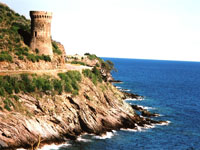
North of Bastia is the holiday destination of Cap Corse, a 25-mile (40km) peninsula edged with quaint fishing villages. The peninsula is divided by a narrow spine of mountains, which rise over 3,000 feet (914m) above sea level. On the east side of the Cap Corse mountain spine are a series of small villages cuddled into picturesque coves, while on the west coast the settlements cling precariously to rugged cliffs battered by wild waves.The peninsula's best stretch of sandy beach to enjoy on holiday is Plage de Tamarone, near Macinaggio. A favourite attraction with holiday visitors in Cap Corse is the charming village of Centuri; favourite activities include hiking and hikers flock to the area to enjoy the many walking trails, like the well-known Sentier des Douaniers. Make sure the camera is loaded for visits to the panoramic viewpoints of Capo Grosso, Moulin Mattei and the Tour de Seneque, above Pino. The vineyards of Patrimonio are renowned, particularly for their muscat, and most wineries welcome holiday visitors for wine tasting. The Cap Corse wine route, or 'route des vins', is signposted from St-Florent.
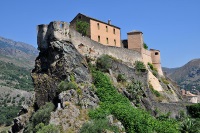
For a change of pace on a beach holiday, pack some hiking boots along with your swimsuit and head for the dramatic Corsican hinterland. Corte lies marooned in the centre of Corsica, surrounded by dramatic granite mountains. This independent and proud town has long epitomised Corsican nationalism - for a short time in the 18th century it was the capital of Pascal Paoli's short-lived Corsican state. Now a university town, it remains dominated by the Haute Ville (upper town) and its forbidding citadel, site of the Musée de la Corse, the island's premier museum. While on holiday in Corte, it is wonderful to spend a morning wandering around the narrow cobbled streets or soaking up the atmosphere in one of the many bars and cafés that line the main street. Corte is an excellent base for exploring the island's wonderful mountain scenery and there are great hikes and walking trails in the area. A few miles to the southwest, near Bergeries de Grotelle, walkers will find a number of glacial lakes, and around Valée de la Restonica there are a series of stunning natural gorges and basins with refreshing swimming spots. Buses and trains connect Corte with Ajaccio, Bastia and other holiday towns on the island.
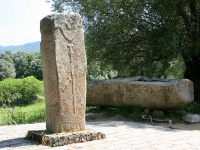
The most celebrated prehistoric site in Corsica, Filitosa is worth a visit for its megalithic menhir statues, which have been carved to represent human faces or armed figures. The purpose of these granite structures is still unclear, and mysteries abound concerning the many ancient structures on the site. Filitosa V, with its sword and dagger, the face of Filitosa IX, and the five menhir statues around the foot of a 1,200-year old olive tree, are the most admired structures of the prehistoric site. A small museum offers further menhirs, as well as some ancient tools and pottery found in the caves, dating back to 3,300 BC. It takes about 45 minutes to walk through the whole site. There is a cafeteria and a gift shop at the site and it is a pretty area to explore. There is an audio guide in a number of languages to give visitors context. As the site is unprotected from the elements it is best to go on a sunny day, but try to avoid the peak hours because the serenity and mystery of this ancient site is far better appreciated without the crowds.
Address : The site lies 11 miles (17km) north of Propriano, and about 25 miles (40km) south of Ajaccio.
Website : www.filitosa.fr
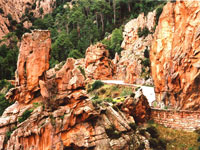
The mass of intriguing red rock formations along the coastal road between Porto and Piana are known as Les Calanques, and are a highlight on a visit to Corsica. The narrow, twisting road reveals a landscape of spectacular vistas and panoramas that outdo each other at every turn, where wind and sea have eroded the pink granite rock into pillars, huge boulders and weird shapes. The scenery is most spectacular at sunset, when the setting sun highlights the natural red and pink colours of the rock, and the drive is best appreciated in the direction from Piana to Porto. The landscape is unlike any other and is truly a pleasure to drive through. Visitors can also explore the rock formations on boats or kayaks - the turquoise water contrasts spectacularly with the red rock. There are some great swimming spots hiding among the rock formations. Probably the best way to explore the landscape, however, is on foot, and there are numerous dramatic walking trails winding along the cliffs and through the forests of the area. Needless to say, one can get some fabulous photographs and find special spots; look out for the heart-shaped hole, you'll know it if you see it.
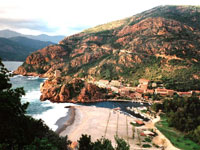
The small seaside holiday resort of Porto is watched over by the 16th-century Genoese Tower standing guard over the fishing harbour, and although crowded in summer, retains a certain charm. While on holiday, Porto is an excellent base from which to explore the surrounding countryside and spectacular coastline. This region of Corsica is so full of natural beauty that it has been designated a UNESCO World Heritage Site so visitors are truly spoilt for choice when it comes to stunning landscapes. The Gorges de Spelunca, a spectacular ravine, is popular for its rocky pools, Genoese bridges and hiking opportunities, while the Forêt d'Aïtone is one of the island's most beautiful forests, with waterfalls and numerous walking trails. Visitors can head out on boat trips as well, and easily access some of the famous calanques along the coast, and the nature reserve of Scandola. The main historical sightseeing attraction is the 16th-century watchtower perched dramatically on the cliffs and boasting phenomenal views. The town itself is not spectacular and has sprung up mainly to meet the demands of the visitors who flock to the area for the natural beauty.
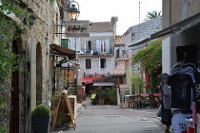
Known as the 'St Tropez of Corsica', Porto-Vecchio is becoming one of the most fashionable towns in southern Corsica. It is situated in a scenic bay, near popular sandy beaches such as Palombaggia, Rondinara, and Santa Guilia. This is the perfect place for a lazy beach holiday in sunny Corsica and visitors are spoiled for choice with all the pleasant spots to set up beach camp for the day. The town itself is also picturesque, particularly the old town, called the Borgo, which boasts winding, narrow streets and interesting sights such as the twisted tree at the Place de la Republique, the incomplete church of St Jean Baptiste, and the art gallery at the Bastion di A Funtana Vechju.Porto-Vecchio has a few souvenir shops and excellent speciality food shops selling Corsican delicacies like wild boar sausage and local cheeses. There are a number of cafes, bars and restaurants providing good vantage points for people-watching, and during the high season the city is usually buzzing with activity. It is a good doorstep to the delights of Corsica and an increasingly glamorous holiday destination which draws many visitors every year.
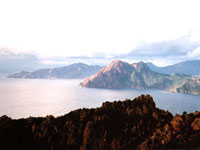
The Cape Girolata peninsula is classified as a UNESCO World Heritage Site and encompasses the Scandola Nature Reserve, an ecological treasure covering 1,000 hectares (2,471 acres) of scrub, cliffs and sea. The promontory is marked by incredible rock formations that were formed by Monte Cinto's volcanic eruptions millions of years ago. The subsequent erosion has fashioned remarkable caves and grottoes deep into the rock. The headland and its surrounding waters support significant colonies of seabirds, dolphins and seals, as well as 450 types of seaweed and some remarkable fish such as the grouper, a species more commonly found in the Caribbean. Due to its valuable biodiversity and landscape Scandola is off-limits to walkers and can be viewed only by boat; trips can be arranged from Calvi, Porto and Ajaccio and make for amazing excursions. Visitors can spend the whole day on a boat tour, stopping off in a picturesque little village for lunch. Equally, one can go for a quick two to three hour jaunt if time is limited. It is also possible to hire boats but it is expensive.

Travel Guide powered by Word Travels, copyright © 2023 Globe Media Ltd. By its very nature information in this travel guide is subject to change at short notice and travellers are urged to verify information on which they're relying with the relevant authorities. Neither Globe Media Ltd nor Travel Vogue can accept any responsibility for any loss or inconvenience to any person as a result of information contained above.